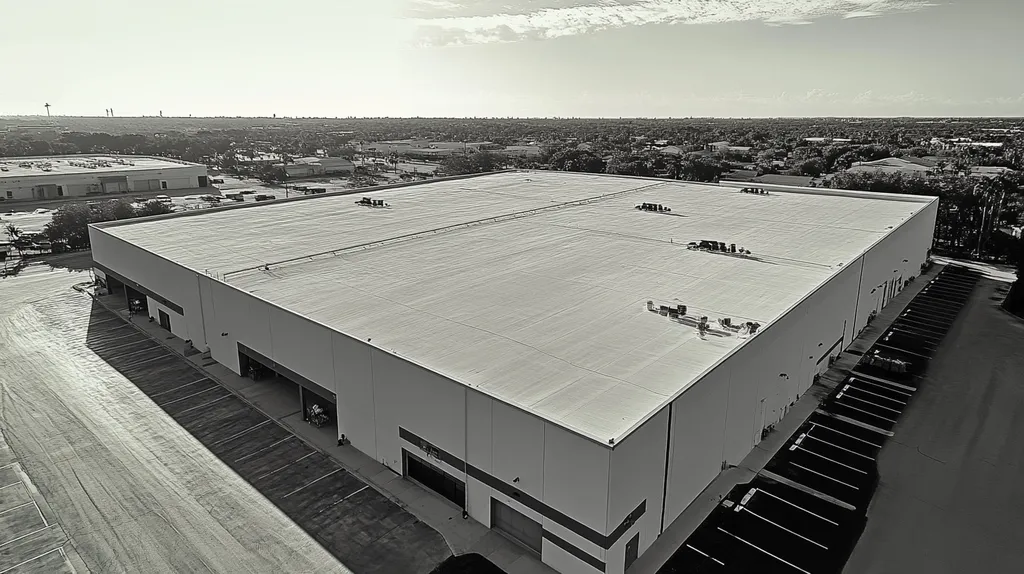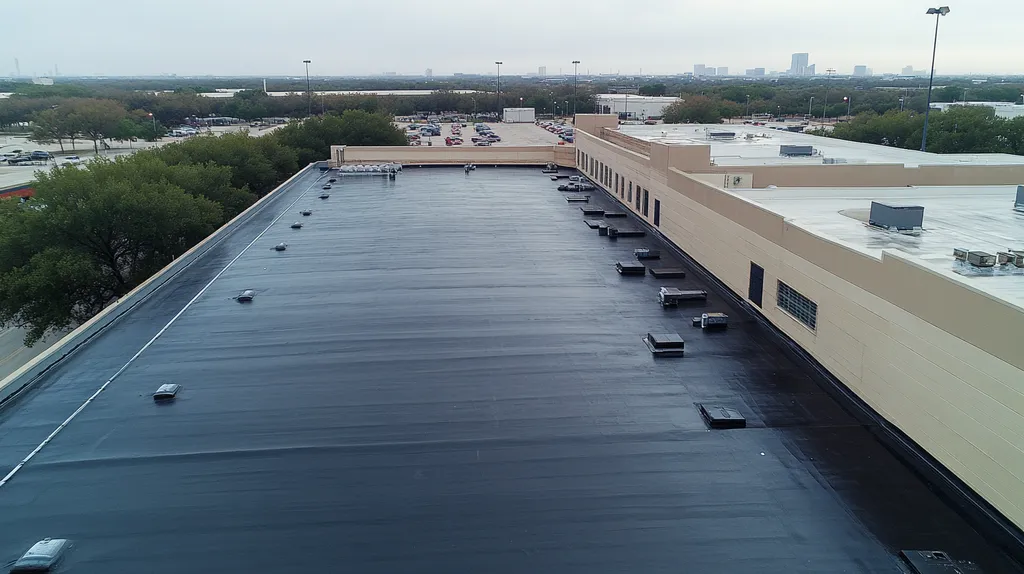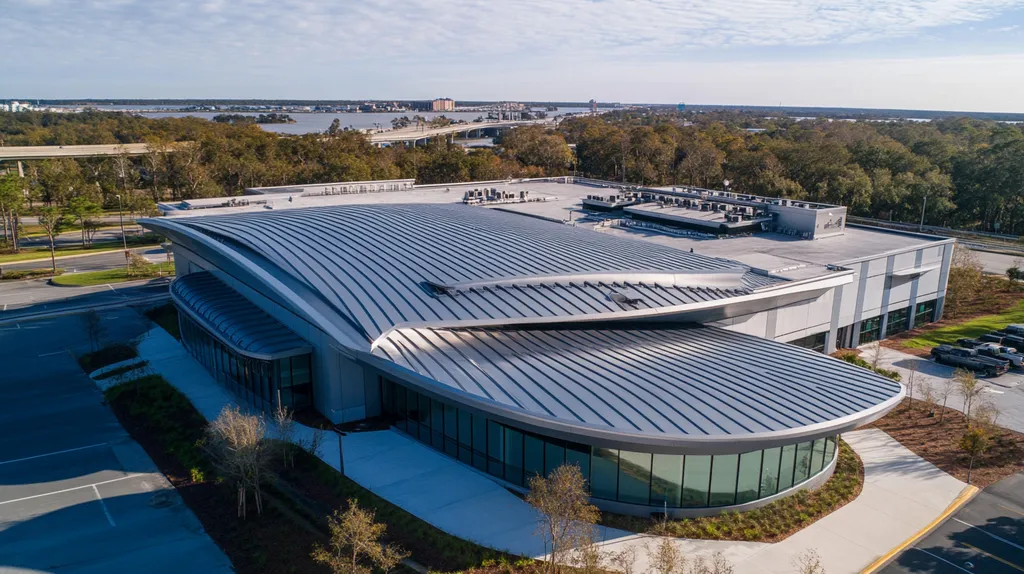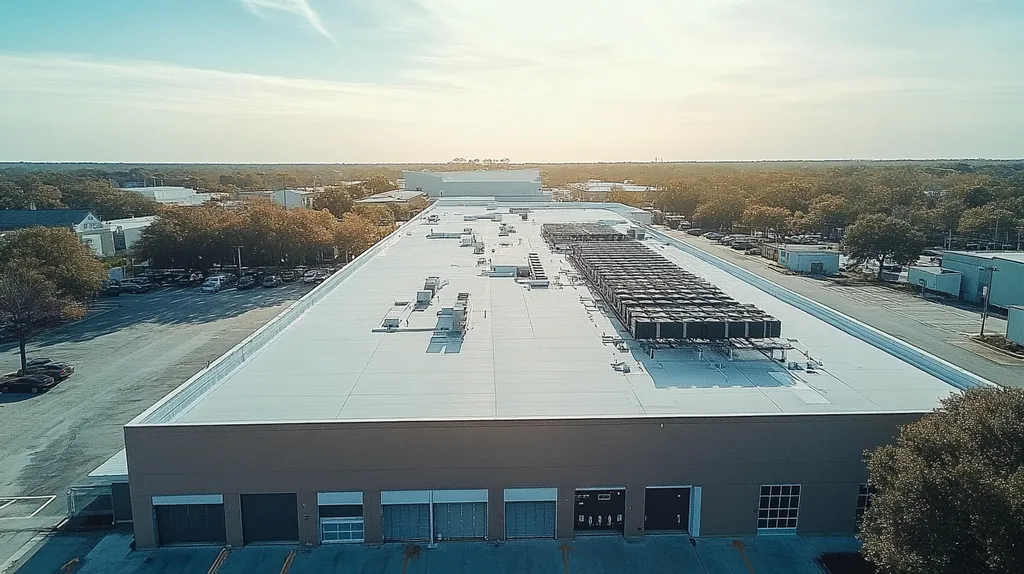Nearly 40% of commercial roofs fail prematurely due to unchecked pollutant exposure, costing facility managers millions in repairs and compliance violations annually.
From industrial emissions to chemical runoff, modern commercial roofs face an unprecedented array of environmental threats that can compromise structural integrity and violate EPA standards.
This comprehensive guide examines the critical intersection of pollutant management and regulatory compliance, providing facility managers with actionable strategies to protect their roofing investments while meeting increasingly stringent environmental requirements.
SECTION 1: PERFORMANCE FACTORS
Roof Material Selection and Pollutant Release
The selection of roofing materials plays a defining role in how pollutants affect roof life. Some materials, such as single-ply membranes, may attract airborne contaminants, which accelerates their deterioration. Conversely, robust metal roofing systems offer superior resistance to pollutant accumulation, extending their lifespan considerably.
Furthermore, certain materials can release volatile organic compounds (VOCs) into the atmosphere, adding to environmental pollutants. Facility managers must carefully assess not only how materials resist external contaminants but also their potential emissions when making selections.
A notable observation is that lighter-colored roofs can reflect more sunlight, thereby reducing heat absorption and potentially mitigating thermal expansion’s effects on pollutants. Thus, attention to color choice can also play a role in combating pollutant-related challenges.
Key Action Items
Impact of Maintenance on Pollutant Levels
Regular maintenance is vital for managing pollutants on commercial roofs. Over time, organic debris and other particles can gather, creating breeding grounds for bacteria and encouraging moisture accumulation. Neglecting these maintenance issues can drastically elevate pollutant levels, significantly increasing the likelihood of roofing failures.
Effective maintenance strategies should encompass routine inspections and debris removal to minimize pollutant build-up. Facilities scheduling quarterly or biannual cleanings often realize better roof performance and increased longevity.
Additionally, applying protective coatings during maintenance can reduce the adherence of pollutants. These coatings not only guard against UV rays and thermal impacts but also lessen the frequency of required cleanings, boosting overall efficiency.
Key Action Items
Ventilation and Airflow Effects
Effective ventilation is crucial in alleviating pollutants’ impact on commercial roofs. Insufficient airflow can trap humidity and pollutants, which accelerates the corrosion of roofing materials. Facility managers should prioritize the installation of adequate ventilation systems to support air movement and mitigate moisture build-up.
In areas with restricted airflow, heat can become trapped, causing roofing materials to undergo irregular expansion and contraction. This stress can heighten the damage inflicted by pollutants, resulting in premature roof failures.
Improving ventilation can also enhance indoor air quality, helping to minimize the spread of harmful particles. By ensuring ventilation channels are clear and operational, facility managers can achieve dual objectives: prolonging the roof’s life and contributing to a healthier indoor environment.
Key Action Items
SECTION 2: FINANCIAL CONSIDERATIONS
The financial stakes in commercial roofing are high, especially when it comes to managing pollutant impact. Facilities that turn a blind eye to roof compliance risk incurring hefty fines and mounting maintenance costs. Studies indicate that roofs lacking effective pollutant mitigation can experience a lifespan reduction of up to 30%. For facility managers, grasping the financial ramifications of pollutant management is crucial to sustaining roof integrity while protecting their budgets.
Cost of Pollutant Mitigation Measures
The initial costs of pollutant mitigation may seem intimidating at first glance. For instance, establishing a routine inspection and cleaning protocol can range from a few hundred to several thousand dollars annually, depending on the facility size. While these upfront expenses can strain finances, the cost of doing nothing typically proves to be far steeper.
Neglecting pollutants often leads to expensive repairs, including significant membrane replacements or structural reinforcements. Choosing high-quality materials that resist contamination may come with a higher initial price tag, but they will ultimately yield savings in the long run. Facility managers must weigh these costs thoughtfully against potential savings.
Moreover, proactive measures like upgraded drainage systems and advanced protective coatings require initial investment but are vital for maintaining roof health. By planning for pollutant management in budgets, facilities can sidestep larger expenses down the line.
Key Action Items
Economic Benefits of Compliance
Meeting environmental regulations opens up a range of economic benefits for facility managers. Compliant roofs are less likely to incur fines or penalties, contributing to a healthier financial outlook. These savings can bolster the bottom line significantly.
Additionally, a roof that adheres to pollution standards enhances a facility’s marketability. Green certifications can draw in environmentally-conscious tenants, often leading to heightened rental income. Properties recognized for their sustainability frequently command premium lease rates.
Furthermore, compliance with standards can lead to lower insurance premiums. Many insurers offer discounts to facilities that meet certain environmental criteria, thus alleviating some financial strain. This approach not only reduces costs but also strengthens overall risk management.
Key Action Items
Long-Term Cost Savings Through Prevention
Strategically managing pollutants can lead to substantial long-term savings for commercial roofs. Facilities that actively mitigate pollutant risks often cut overall costs dramatically. For example, regular maintenance can noticeably extend a roof’s lifespan.
It’s typically more cost-efficient to maintain and clean a roof routinely than to tackle significant repairs afterward. Catching small issues early can prevent extensive damage down the line, ultimately leading to a healthier financial strategy.
Additionally, well-managed roofs that resist pollutants require fewer replacements and repairs, thereby significantly decreasing lifecycle costs. While preventative measures may involve upfront expenses, the long-term financial dividends can far surpass the initial outlay.
Key Action Items
SECTION 3: COMPLIANCE REQUIREMENTS
Understanding compliance with environmental regulations is essential for commercial roof management, particularly in today’s climate of increased regulatory scrutiny. Property owners and facility managers must familiarize themselves with the Environmental Protection Agency (EPA) guidelines and their impacts on roof design and maintenance. Failure to comply can lead not only to substantial fines but also to reputational damage that can hinder business operations. This section outlines critical areas of compliance: EPA regulations, stormwater management plans, and the safe handling of hazardous materials.
EPA Regulations and Guidelines
Adhering to EPA regulations is a cornerstone of effective roof management. These directives detail how to manage pollutants that may contaminate stormwater systems, requiring roofs to be designed for minimal runoff. Non-compliance can result in serious legal repercussions, including heavy fines.
When selecting roofing materials, facility managers should consider the EPA’s stance on volatile organic compounds (VOCs). Choosing low-VOC products not only meets compliance but also contributes to a healthier environment. Regular audits and thorough assessments can help ensure that facilities remain compliant and sustainable.
Moreover, integrating the Clean Water Act into daily operations is vital. Keeping accurate documentation regarding pollutants and management practices demonstrates a commitment to compliance and operational efficiency. Staying updated on any changes to EPA regulations is also crucial, necessitating ongoing training and education for facility managers.
Key Action Items
Stormwater Pollution Prevention Plans (SWPPP)
The implementation of Stormwater Pollution Prevention Plans (SWPPP) is indispensable for commercial roofs. These plans proactively identify and mitigate the risk of pollutants being washed off roofs during rainfall. An effective SWPPP enhances water quality and is often a legal requirement.
A comprehensive SWPPP includes regular site assessments, staff training, and targeted pollution prevention strategies. Facility managers must conduct routine roof inspections to spot vulnerabilities and address issues, such as keeping drainage systems clear to avoid water pooling.
Documentation is crucial for any SWPPP. Maintaining thorough records of inspections, training, and maintenance activities demonstrates compliance to regulators. Collaborating with local environmental agencies when creating a SWPPP can also lead to tailored solutions that benefit both the facility and the surrounding environment.
Key Action Items
Asbestos and Hazardous Material Handling
The management of hazardous materials like asbestos is crucial for maintaining compliance in commercial roofing. Older buildings, especially those constructed before the 1980s, may still contain asbestos, which poses both health risks and regulatory challenges.
Property owners must conduct thorough inspections to identify any hazardous materials and manage them appropriately. In cases of asbestos presence, only licensed professionals should handle removal and disposal to ensure compliance with safety regulations.
It is equally important to adhere to regulations when performing maintenance or renovations on roofs with hazardous materials. Facility managers should only work with certified contractors who understand safe practices for asbestos handling. Continuous staff training about hazardous materials also helps prevent accidental exposure and ensures compliance with safety guidelines.
Key Action Items
SECTION 4: RISK MANAGEMENT
As commercial properties age, the threat of pollutants becomes a significant concern for facility managers and property owners. Pollutants can chemically erode roofing materials, undermine structural integrity, and lead to expensive repairs. According to the EPA, poor indoor air quality can reduce worker productivity by up to 30%. Understanding these risks is not just essential for compliance; it’s foundational for financial stability.
Identifying Potential Pollutant Sources
The first step in effective risk management is pinpointing the origins of pollutants. Common sources include industrial emissions, vehicle exhaust, and nearby construction activities. Each of these can deposit harmful substances on the roof, increasing the risk of damage over time.
Thorough site assessments conducted by facility managers are crucial. Regular inspections can uncover issues like overhanging branches, malfunctioning HVAC systems, and clogged drainage. By taking proactive measures, property managers can identify and mitigate potential pollutant sources before they escalate into major problems.
Collaboration with environmental specialists also provides valuable insights. These experts can help uncover hidden risks like lead or asbestos from building materials, creating a more comprehensive risk profile. Understanding where pollutants come from allows managers to implement targeted strategies that significantly enhance roof longevity and compliance.
Key Action Items
Assessing Health and Environmental Risks
After identifying potential sources, the next step involves assessing the health and environmental risks associated with these pollutants. These contaminants can compromise indoor air quality and pose health hazards for building occupants.
Facility managers must evaluate the severity of these risks. Prolonged exposure to certain chemicals can lead to respiratory issues, while polluted runoff may threaten local water systems and attract regulatory scrutiny. Understanding the full range of impacts is crucial.
Staying informed about local regulations related to pollutants not only ensures compliance but also aids in decision-making. Implementing monitoring systems can further facilitate ongoing risk assessment. Thorough risk evaluations help prevent costly liabilities and protect both occupants’ health and the surrounding ecosystem.
Key Action Items
Implementing Risk Reduction Strategies
To manage risks effectively, facility managers should adopt comprehensive risk reduction strategies. These may include establishing routine maintenance schedules and tailored cleaning procedures based on local climate and environmental conditions.
For instance, applying protective coatings can shield roofs from the damaging effects of pollutants. Additionally, integrating advanced filtration systems can enhance air quality and reduce incoming contaminants.
Training maintenance staff on pollutant management is equally essential. When the team understands the specific risks and effective response strategies, they can intervene more quickly to mitigate issues. A robust risk management plan isn’t a one-time effort; it requires continuous monitoring and refinement to adapt to evolving regulations and conditions.
Key Action Items
SECTION 5: OPERATIONAL PROCEDURES
Maintaining the integrity of commercial roofs is not just a good practice; it’s essential in reducing the damaging effects of pollutants. Regular inspections can prevent severe damage, cut operational costs, and ensure adherence to building regulations. Failing to implement solid operational procedures can lead to significant financial penalties and costly repairs. Consequently, facility managers must establish systematic practices to tackle the impact of pollutants on roofing systems.
Regular Roof Inspections and Maintenance
Frequent inspections are vital for spotting early signs of pollutant-related damage. Facility managers should adopt a quarterly inspection routine to assess roof conditions, focusing on debris accumulation, membrane durability, and drainage efficiency. Research demonstrates that preventive maintenance can significantly extend a roof’s lifespan, often by 30% or more.
During inspections, documentation of findings is crucial, allowing facility managers to take swift action on any issues. For example, if standing water is discovered, immediate drainage improvements should follow to mitigate long-term damage. Addressing problems promptly not only averts further deterioration but also ensures compliance with the required standards.
Incorporating technology like drones for inspections can enhance oversight, revealing detailed images of hard-to-reach areas. This modern approach allows teams to assess potential issues without the risks associated with traditional methods, ensuring comprehensive evaluation of the roofing system.
Additionally, maintaining a log of inspections, repairs, and treatments facilitates tracking roof performance and provides critical documentation for compliance verification during regulatory inspections.
Key Action Items
Proper Use of Roofing Materials and Treatments
Selecting the appropriate materials and treatments is crucial for combating the effects of environmental pollutants. For instance, reflective roofing materials can reduce heat absorption, leading to lower energy costs and a longer life for the roof. Facility managers should prioritize products verified for their durability against local pollution types.
Utilizing sealants and coatings specifically formulated to resist chemical exposure offers further protection for roofing surfaces. Choosing environmentally-friendly treatments not only aligns with sustainability objectives but also lowers ongoing maintenance costs by minimizing damage from harmful pollutants.
Ensuring correct installation practices according to manufacturer guidelines is essential to optimize material performance. Mistakes in applying roofing materials can result in failures that go unnoticed during inspections, leading to compliance issues and increased repair costs.
Furthermore, staying current with advancements in roofing technology empowers managers with options for enhancing roof durability. Organizing routine training on new products and application methods equips teams to make well-informed decisions regarding roofing materials.
Key Action Items
Training for Roofing and Maintenance Personnel
Ongoing training for maintenance personnel is vital for ensuring roof compliance and longevity. Personnel need to comprehend the specific pollutants that can affect their roofing systems and adopt best practices to mitigate these risks. Training programs should include modules focusing on pollutant impacts and effective maintenance techniques.
Moreover, continuous education in safety protocols during inspections and maintenance tasks is crucial. Familiarity with safe working practices protects employees while promoting a compliant and efficient roofing system. Incorporating hands-on training enhances skill sets and boosts personnel confidence in addressing roofing challenges.
Building partnerships with roofing experts for specialized training can provide facility managers with invaluable insights. Workshops led by industry professionals offer practical knowledge on troubleshooting and effective maintenance strategies that adhere to regulatory requirements.
Ultimately, investing in a well-trained team is an essential asset, reducing the likelihood of compliance violations. By emphasizing education, facility managers equip their personnel to proactively handle maintenance tasks, preserving the roofing system’s integrity against environmental pollutants.
Key Action Items
SECTION 5: OPERATIONAL PROCEDURES
Ensuring the integrity of commercial roofs is vital for tackling the detrimental effects of pollutants. Regular inspections can avert extensive damage, lower operational costs, and guarantee adherence to building regulations. Without effective operational procedures, property owners may face hefty financial penalties and costly repairs. To navigate these challenges, facility managers must implement clear strategies to mitigate the impact of pollutants on roofing systems.
Regular Roof Inspections and Maintenance
Consistent roof inspections are key to catching early signs of pollutant-related damage. Facility managers should establish a quarterly inspection schedule to evaluate roof conditions, focusing on debris accumulation, membrane integrity, and drainage efficiency. Research has shown that proactive maintenance can extend roofing systems’ lifespan by 30% or more.
Active documentation during inspections is essential, allowing for swift action on identified issues. For example, if pooling water is detected, prompt improvements to drainage should be prioritized to minimize long-term damage. Taking timely action not only halts further degradation but also keeps roofs compliant with regulatory standards.
Incorporating technology, such as drones, can also significantly enhance roof inspections by providing detailed imagery of hard-to-reach areas. This modern approach eliminates risks associated with traditional inspection methods while ensuring comprehensive evaluations of roofing systems.
Lastly, maintaining a thorough log of inspections, repairs, and treatments is necessary for tracking roof performance. This documentation serves as valuable proof during audits from regulatory bodies.
Key Action Items
Proper Use of Roofing Materials and Treatments
Choosing appropriate materials and treatments is vital for combating the effects of environmental pollutants. For instance, reflective roofing materials can significantly mitigate heat absorption, leading to reduced energy costs and a longer roof lifespan. Facility managers should prioritize products proven for durability against local pollutants.
Applying sealants and coatings specifically formulated to resist chemical exposure further protects roofing surfaces from degradation. Utilizing environmentally-friendly treatments not only aligns with sustainability goals but also lowers ongoing maintenance costs by preventing damage from harmful pollutants.
Moreover, ensuring proper installation practices aligned with manufacturer specifications is crucial for optimizing material performance. Errors in applying roofing materials can lead to unnoticed failures during inspections, which may cause compliance issues and escalated repair costs.
Furthermore, staying informed about advancements in roofing technology empowers managers with enhanced options. Regular training sessions on new products and application methods can equip teams with informed decision-making capabilities regarding roofing materials.
Key Action Items
Training for Roofing and Maintenance Personnel
Investing in regular training for maintenance personnel is crucial for ensuring roof compliance and longevity. Staff should fully understand the specific pollutants affecting their roofing systems and best practices for mitigating these risks. Training programs should include modules on pollutant impacts and effective maintenance techniques.
Additionally, continuous education in safety protocols is essential for inspections and maintenance tasks. Familiarity with safe working practices safeguards employees while promoting a compliant and efficient roofing system. Incorporating hands-on training enhances skill sets and confidence in tackling roofing challenges.
Facility managers should consider partnerships with roofing experts for specialized training sessions. Workshops led by industry professionals can provide valuable insights on troubleshooting and maintenance strategies that meet regulatory requirements.
Ultimately, a well-trained team is a critical asset that can substantially reduce the risk of compliance violations. By emphasizing education, facility managers empower personnel to proactively handle maintenance tasks, preserving the roofing system’s integrity against harmful pollutants.
Key Action Items
Looking Ahead
With 40% of commercial roofs failing prematurely due to pollutant exposure, facility managers can no longer afford reactive approaches to compliance.
The integration of robust inspection protocols, proper material selection, and comprehensive staff training represents the foundation of effective pollutant management.
Advanced technologies like drone inspections and IoT sensors are revolutionizing how facilities monitor and address pollutant impacts, offering unprecedented oversight capabilities.
As environmental regulations continue to evolve and enforcement intensifies, proactive pollutant management isn’t just about avoiding fines – it’s about ensuring sustainable building operations.
The future of commercial roofing lies in the hands of those who recognize that compliance, cost management, and environmental stewardship are inextricably linked.
FREQUENTLY ASKED QUESTIONS
Q. How do pollutants impact commercial roof performance?
A. Pollutants can lead to significant deterioration in roofing materials, shortening their lifespan. Regular maintenance and appropriate material selection are crucial for mitigating these effects and ensuring long-term durability.
Q. What are the financial implications of managing pollutants on industrial roofs?
A. Effective management of pollutants can prevent costly repairs and extend the roof’s lifespan significantly. While initial costs may seem high, proactive maintenance often leads to long-term savings and improved compliance with regulations.
Q. How can compliance with EPA guidelines protect commercial roofs?
A. Adhering to EPA guidelines helps prevent contaminants from adversely impacting the environment and the integrity of the roofing system, reducing the risk of penalties and educating facility managers on effective pollutant management practices.
Q. What steps can facility managers take for effective risk management regarding pollutants?
A. Conduct regular site assessments to identify potential pollutant sources and implement cleaning and maintenance schedules. Additionally, training staff on pollutant management will greatly enhance overall risk management strategies.
Q. Why are regular inspections necessary for commercial roofs?
A. Regular inspections are essential for detecting issues early, preventing expensive repairs, and ensuring compliance with safety standards. This proactive approach greatly enhances roof longevity and performance.
Q. How does proper training support roof maintenance personnel?
A. Proper training ensures that maintenance personnel understand the impact of pollutants and best practices for mitigation. This knowledge is vital for maintaining compliance, safety, and the overall effectiveness of primary roofing strategies.
Q. What innovative strategies can be employed for maintaining industrial roofs?
A. Innovative strategies such as using drone technology for inspections and advanced coatings that resist pollutants can greatly enhance the efficiency of maintenance practices while ensuring compliance with evolving regulations.











